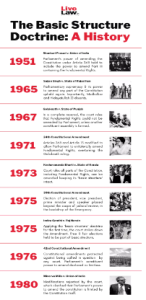Context:
The former CJI recently remarked that the basic structure of the Constitution has a “debatable jurisprudential basis”.
What is the Basic Structure Doctrine?

- The Doctrine of Basic Structure is a form of judicial review that is used to test the legality of any legislation by the courts.
- The doctrine was evolved by the Supreme Court in the 1973 landmark ruling in Kesavananda Bharati v State of Kerala.
- In a 7-6 verdict, a 13-judge Constitution Bench ruled that the ‘basic structure’ of the Constitution is inviolable, and could not be amended by Parliament.
- If a law is found to “damage or destroy” the “basic features of the Constitution”, the Court declares it unconstitutional.
- The test is applied to constitutional amendments to ensure the amendment does not dilute the fundamentals of the Constitutional itself.
- The test is widely regarded as a check on majoritarian impulses of the Parliament since it places substantive limits on the power to amend the Constitution.
First Amendment Act, 1951:
- The 1951 Constitution (First Amendment) Act of India, allowed for amending the Fundamental Rights provisions.
- It sought to make several consequential changes from exempting land reforms from scrutiny to providing protections for backward classes in the Constitution.
- It also expanded on the scope of the restrictions on the right to free speech.
- This enabled the government to address specific policy and program needs, even if it meant limiting freedom of speech and expression.
- The amendment supported the abolition of zamindari and clarified that the right to equality could accommodate laws focusing on marginalized groups.
Emergence of Basic Structure Doctrine:
- The Kesavananda ruling was a culmination of a series of tussles between the judiciary and the executive.
- The Parliament brought in a constitutional amendment to give itself the power to amend any part of the Constitution and passed a law that it cannot be reviewed by the courts after a reversal of key legislation including land reforms; nationalization of banks; abolition of privy purse.
- The Court had to then examine the scope of the Parliament’s power to amend the Constitution and the legality of the land reforms.
- The Court ruled that while Parliament has vast powers to amend the Constitution, it cannot amend certain “basic features.”
Basic Features of the Indian Constitution:
- The term ‘basic structure’ is not defined, however, over the years, the Supreme Court through its various judgements has shaped the concept of ‘Basic structure of Constitution’.
- In the Kesavananda ruling, the Supreme Court cited several aspects of the Constitution that could be identified as “basic features” of the document but added that it was not an exhaustive list.
Components of Basic Structure:
- Supremacy of the Constitution;
- Republican and Democratic forms of Government.
- Secular character of the Constitution;
- Separation of powers between the Legislature, the executive and the judiciary;
- Federal character of the Constitution
Application of the Basic Structure Doctrine:
- The “Basic structure” theory was applied for the first time after its introduction in the 1975 case Indira Gandhi v. Raj Narain.
- The Allahabad High Court had ruled against Indira Gandhi and convicted her of electoral malpractices in the Lok Sabha election, after a challenge by rival Raj Narain.
- The five-judge Bench, categorised the independent conduct of elections as “basic structure” and ruled that Parliament could not amend the Constitution if alterations affected basic issues like fundamental rights.
Arguments Against Basic Structure Doctrine:
- Not Mentioned in Constitution: It is not found in the text of the Constitution itself.
- Anti-democratic: The power of “unelected judges” to strike down amendments to the Constitution on the basis of this doctrine is “anti-democratic and counter-majoritarian.”
- Judicial overreach over the legislature: The doctrine accords the judiciary a power to impose its philosophy over a democratically formed government, resulting in tyranny of the elected.
Arguments in Favour of Basic Structure Doctrine:
- Maintaining the Sanctity of Constitution: The test is applied to constitutional amendments to ensure the amendment does not dilute the fundamentals of the Constitutional itself.
- Check on Majoritarian impulses: The test is widely regarded as a check on majoritarian impulses of the Parliament since it places substantive limits on the power to amend the Constitution.
Conclusion:
- The Basic Structure doctrine is one of the biggest contributions of the Indian Judiciary to the theory of constitutionalism.
- The doctrine has helped in maintaining supremacy of the Constitution and has prevented its destruction by a temporary majority in Parliament.
- It acts as a limitation upon the constituent power and has helped in arresting the forces which may destabilize the democracy.
- Parliament does not and should not have an unlimited power to amend the Constitution. This basic structure doctrine, as future events showed, saved Indian democracy.
News Source: Indian Express
To get PDF version, Please click on "Print PDF" button.

